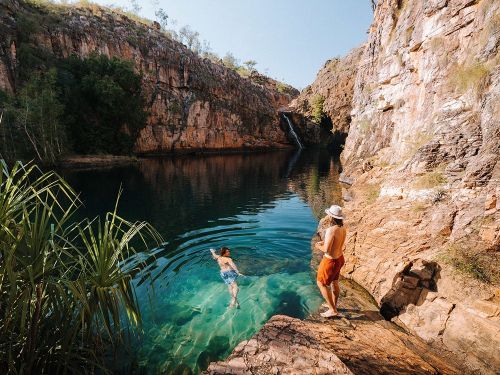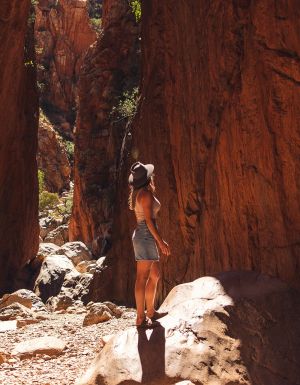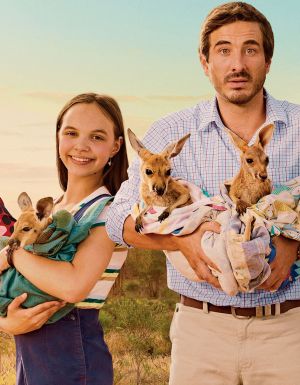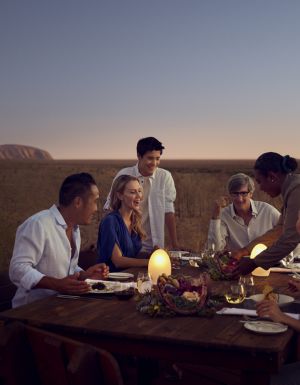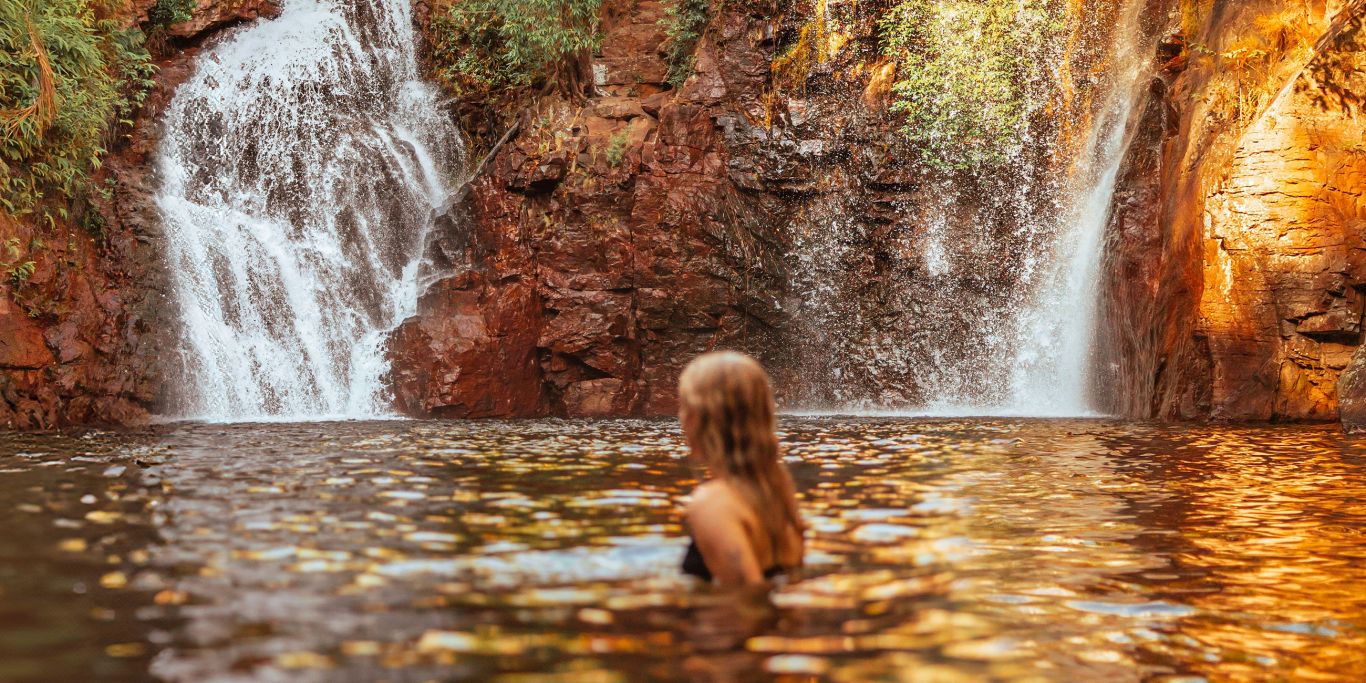See three of Australia’s best national parks by following this stunning Top End outback itinerary from Darwin.
The Top End is every adventurous traveller’s notion of outback Australia: big skies, bold landscapes, termite mounds, ancient rock art and the thrill of crocodiles. Everyone should see Kakadu at least once in their lives, but Litchfield and Nitmiluk national parks are wonderful, too. Hit the road, red dust swirling behind you, and you won’t be disappointed.

Our driving loop from Darwin covers about 1100 kilometres, not counting detours off the main route. We recommend a minimum of seven days. You don’t have to be Crocodile Dundee to tackle it. In fact, all the highlights are accessible on surfaced roads (although some might close in the wet season). And you don’t have to pitch a tent if that’s not for you. You can hire a campervan in Darwin, or book accommodation along the way. So what are you waiting for? Keep an eye on bouncing wildlife, check your petrol gauge, and get going.

Darwin to Kakadu: the outback adventure begins
Only a half-hour drive from Darwin, the urban sprawl dwindles and red earth takes over. Turn off at Humpty Doo onto the Arnhem Highway and you’ll begin to feel the outback’s immensity. Pause at Fogg Dam Conservation Area for a short walk among abundant birds, and perhaps your first glimpse of a crocodile snout. Stop at the Purple Mango Cafe & Brewery in Marrakai for tasty wood-fired pizzas and a locally brewed beer in a cosy bush setting.

Consider leaving the highway in the Mary River region, where paperbark woodland, wetlands and carpets of water lilies collide to provide spectacular home to more than 200 bird species in vast flocks. Various companies offer wetland cruises and barramundi fishing charters. Our top tip? A sunset excursion by airboat. Sea eagles perch on dead trees, brolgas dance, kingfishers spark and the evening explodes in orange.

Kakadu’s service centre, Jabiru, is 250 kilometres from Darwin. Bowali Visitor Centre provides insight into the national park’s history. Nearly all of Kakadu’s main sights are accessible along tarred roads, but do check conditions if you’re tackling 4WD tracks. Campgrounds range from reasonable to rugged bushland, or you can opt for accommodation such as Mercure Kakadu Crocodile Hotel, Anbinik Kakadu Resort or Cooinda Lodge Kakadu.

Kakadu National Park: outback icon
Count on several days to appreciate the national park. Kakadu features stacked rock, escarpments, waterfalls, glassy billabongs, abundant wildlife and superb rock art. On your first day, head to Ubirr’s rock shelters, emblazoned with paintings of kangaroos and fish. Views of Kakadu’s floodplains from the escarpment are magnificent at sunset.

The adventurous could drive onwards into Arnhem Land in the dry season, but you’ll need serious 4WD skills and a Northern Land Council permit to explore one of Australia’s most remote frontiers. Otherwise, head southwest from Jabiru on the sealed Kakadu Highway for similar landscapes and cultural connections.

Burrungkuy (or Nourlangie) has an extensive gallery of rock art. Another must-do in Kakadu is a Yellow Water cruise, which is most impressive at dawn and dusk. You’re bound to see crocodiles, and the birdlife is magnificent.

Our top tip next morning would be Maguk Waterfall , though it’s only accessible with a 4WD. (The road is unsealed so check the conditions before setting out.) The waterfall flies under the Kakadu radar, but has brilliant waterholes cupped in red rock. You will also need to set off early to complete the 7.5-kilometre-return walk to Motor Car Falls, a picturesque plunge pool surrounded by tropical forest.

Kakadu to Katherine: land of grand canyons
The entire drive from Jabiru back onto the Stuart Highway takes a little more than two hours. That brings you to Pine Creek, where you can stretch your legs by looking around the former gold-rush town, old telegraph station and Railway Museum. Katherine, only an hour’s drive further south, marks your furthest point from Darwin.

First, turn off the highway for paperbark-fringed Leliyn (Edith Falls), a significant cultural site of the Jawoyn people Nitmiluk National Park ’s edge, and a lovely spot for a swim or hike. Our suggestion here is the nine-kilometre return hike to Sweetwater Pool, where you can enjoy a more remote, secluded dip.

Katherine itself has a good range of accommodation if you aren’t camping. Otherwise, the big attraction is just 20 minutes from town and has campgrounds and bush camping where you can watch wallabies and bowerbirds hop. Nitmiluk (Katherine) Gorge, also part of Nitmiluk National Park, is actually a series of 13 gorges framed in great crumbling red cliffs, and is best admired from a kayak or sightseeing boat – though a helicopter ride is fabulous, too.

Katherine to Darwin: last leg to Litchfield
From Katherine back to Darwin it’s 317 kilometres, but you won’t want to rush it. Take a break at the town of Adelaide River and hop aboard a jumping-crocodile cruise. The sound of massive jaws snapping on chunks of buffalo will have you leaping out of your chair, too. Then check out the town’s Second World War cemetery and Railway Heritage Precinct.

Another great stop on the Stuart Highway just before Darwin is Berry Springs Nature Park , where the cooling blue-green woodland pools call out for a swim. Nearby Territory Wildlife Park gets you close to the critters you spotted more distantly in the wild. It’s also your chance to see nocturnal animals such as ghost bats and quolls.

Before you get that far, though, you must absolutely detour at Batchelor to Litchfield National Park. Although it’s near enough to Darwin to be reachable on a day trip, hurrying through would be a big mistake. This place is magical and, once day visitors have departed, its silence and beauty are haunting. Litchfield’s red termite mounds are magnificent when they glow at sunset, and the stars are staggering at night.

Landscapes range from monsoon rainforest to sandstone escarpment. Litchfield is, however, best known for its waterfalls, a superb sight during the wet season, and one of the few places in the region open year-round for swimming. Double-barrelled Wangi Falls has easy access but, if you have a 4WD, our top tip is to get off the more beaten track to Tjaynera Falls or Surprise Creek Falls, and into another brilliant corner of the Top End.
